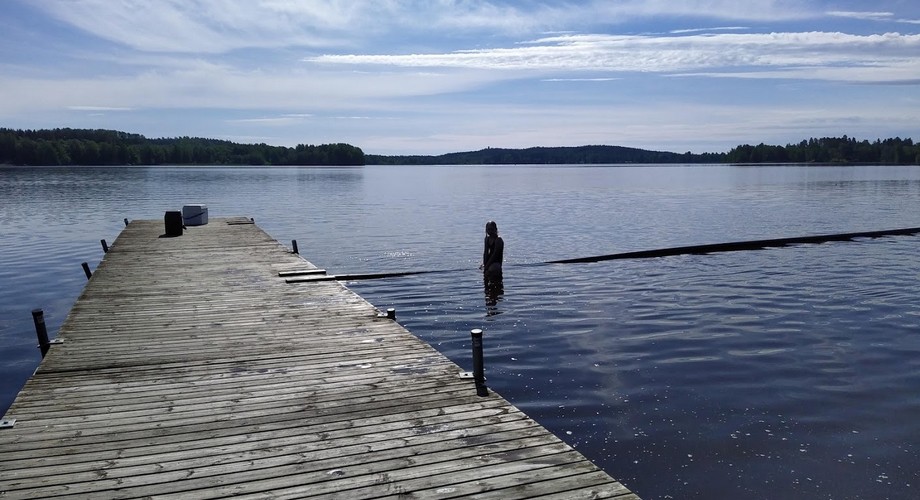The distance between the wastewater source and the bathing area affects the waterborne infection risks, particularly for norovirus

In Finland, the quality of bathing water is generally good, but water contamination events occur from time to time. Water quality may be impaired by various wastewater leakages and emissions such as sewage water that enters the environment in the event of a pump failure, as well as by run-offs from animal faeces in the environment caused by rainstorms.
The study of runoff water-related infection risks investigated infection risks caused by norovirus and campylobacter in bathing water. The study used the Quantitative Microbial Risk Assessment tool, QMRA.
The calculations show that the risk of getting a viral gastroenteritis caused by norovirus from bathing water is greater than the risk of campylobacter infection. The distance between the wastewater source, such as the discharge pipe of a municipal wastewater treatment plant, and the swimming beach is of great importance. If the wastewater ends up close to beaches, especially the risk of norovirus infections increases significantly, 1.5 to 20-fold. However, the drainage waters of the animal farms did not cause as much risk of infection.
“When people gather on beaches during heat waves, the number of those exposed to potential contamination increases. To avoid risk of waterborne infection, one should not swallow bathing water or other surface water”, says Päivi Meriläinen, Senior Researcher at THL.
The study also calculated the number of infections in an imaginary flood situation at a groundwater intake plant if river water ends up in drinking water. In this case, many people could end up using drinking water that contains pathogenic microbes, which could lead to a significant number of people falling ill.
The contaminant dilution were studied using gene markers
The purified wastewater is discharged from municipal sewage treatment plants through discharge pipes to the downstream watershed. During the purification, wastewater is mainly cleaned of nutrients, and disinfection of wastewater before its being discharged is still quite rare. Thus, even when purified, wastewater contains quite a lot of intestinal microbes. For the target areas studied, a wastewater dilution factor was calculated. The calculations utilised the genetic marker method.
The number of HF183 microbial source tracking markers associated with human faecal pollution that were measured at wastewater discharge sites were compared with the number these markers found at beaches. Actual pathogenic microbes can be expected to be diluted in the same proportion.
"A similar procedure can be further used also in other water sites where there is a need to evaluate microbial risks of water users”, says Tarja Pitkänen, Chief Specialist at THL.
Innovative solutions for wastewater and runoff water purification
Due to land use, it is not always possible to avoid sewage and runoff water ending up in the vicinity of bathing areas. In this case, cost-effective purification methods are needed. One of the most effective solutions is to build wetlands. Also, a variety of filtration and disinfection solutions may be used.
“This spring, we have tested the ability of biochar filters to remove wastewater microbes in laboratory conditions”, says Jarkko Nummela, Research Service Chief at the Häme University of Applied Sciences.
The project will also investigate the functionality of the sand-biochar filter installed in the drain that leads to the Loimijoki river in the Ypäjä Hevosopisto area and will study disinfection solutions based on low energy UV LED technology.
Multi-actor joint project
The studies are part of the project called Häme as a pioneer in the management of municipal wastewater and livestock farm runoff to prevent water-borne infection risks (VAIR project) whose participants are the Lammi Biological Station of the University of Helsinki, the Finnish Institute for Health and Welfare, the Häme University of Applied Sciences and Natural Resources Center. The project is funded by the European Regional Development Fund (ERDF) and the Häme Union. HS-Vesi and Riihimäen Vesi also fund the project.
The original article that has investigated the applicability of various methods to trace pollution sources in Finland has been approved for publication in the journal Frontiers in Microbiology.
On 26 May 2021, the project is organising an international expert seminar called ‘Solutions Preventing hygiene and other contamination Risks caused by discharged waters´. The seminar is part of the Bioeconomy Open Week event.
Additional information
Open Bioeconomy Week event 25-27 May 2021
Tiina Tulonen
Project Manager
University of Helsinki
tel. 050 357 3126
[email protected]
Tarja Pitkänen (water-borne infection risks)
Chief Specialist
THL
tel. 029 524 6315
[email protected]
Markku Saastamoinen (livestock farms)
Leading Researcher
pplied Sciences and Natural Resources Center
tel. 040 546 9879
[email protected]
Jarkko Nummela (biochar)
Research Service Chief
HAMK Bio
tel. 050 574 5193
[email protected]
Harri Mattila (international cooperation)
research professor
HAMK
tel. 050 554 5645
[email protected]



